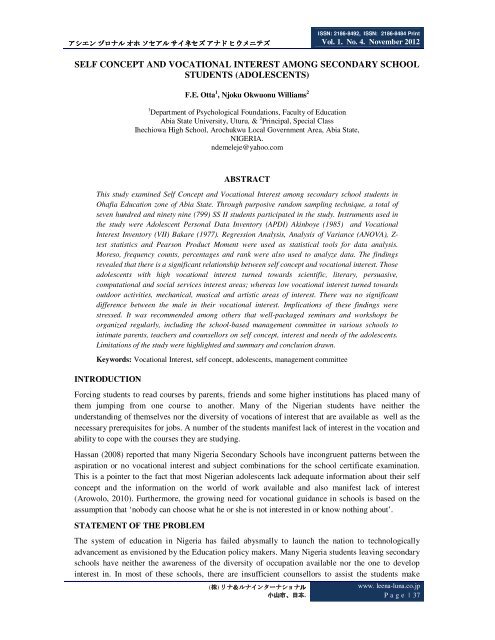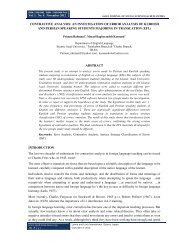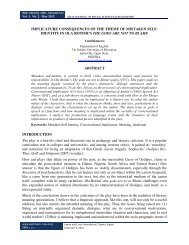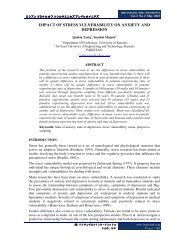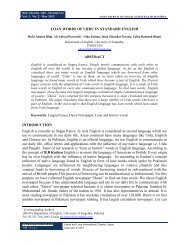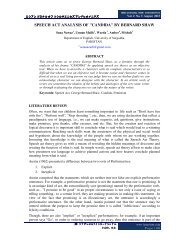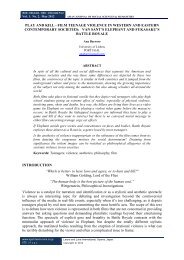self concept and vocational interest among secondary school ...
self concept and vocational interest among secondary school ...
self concept and vocational interest among secondary school ...
You also want an ePaper? Increase the reach of your titles
YUMPU automatically turns print PDFs into web optimized ePapers that Google loves.
アシエン ヅロナル オホ ソセアル サイネセズ アナド ヒウメニテズ<br />
ISSN: 2186-8492, ISSN: 2186-8484 Print<br />
Vol. 1. No. 4. November 2012<br />
SELF CONCEPT AND VOCATIONAL INTEREST AMONG SECONDARY SCHOOL<br />
STUDENTS (ADOLESCENTS)<br />
F.E. Otta 1 , Njoku Okwuonu Williams 2<br />
1 Department of Psychological Foundations, Faculty of Education<br />
Abia State University, Uturu, & 2 Principal, Special Class<br />
Ihechiowa High School, Arochukwu Local Government Area, Abia State,<br />
NIGERIA.<br />
ndemeleje@yahoo.com<br />
ABSTRACT<br />
This study examined Self Concept <strong>and</strong> Vocational Interest <strong>among</strong> <strong>secondary</strong> <strong>school</strong> students in<br />
Ohafia Education zone of Abia State. Through purposive r<strong>and</strong>om sampling technique, a total of<br />
seven hundred <strong>and</strong> ninety nine (799) SS II students participated in the study. Instruments used in<br />
the study were Adolescent Personal Data Inventory (APDI) Akinboye (1985) <strong>and</strong> Vocational<br />
Interest Inventory (VII) Bakare (1977). Regression Analysis, Analysis of Variance (ANOVA), Z-<br />
test statistics <strong>and</strong> Pearson Product Moment were used as statistical tools for data analysis.<br />
Moreso, frequency counts, percentages <strong>and</strong> rank were also used to analyze data. The findings<br />
revealed that there is a significant relationship between <strong>self</strong> <strong>concept</strong> <strong>and</strong> <strong>vocational</strong> <strong>interest</strong>. Those<br />
adolescents with high <strong>vocational</strong> <strong>interest</strong> turned towards scientific, literary, persuasive,<br />
computational <strong>and</strong> social services <strong>interest</strong> areas; whereas low <strong>vocational</strong> <strong>interest</strong> turned towards<br />
outdoor activities, mechanical, musical <strong>and</strong> artistic areas of <strong>interest</strong>. There was no significant<br />
difference between the male in their <strong>vocational</strong> <strong>interest</strong>. Implications of these findings were<br />
stressed. It was recommended <strong>among</strong> others that well-packaged seminars <strong>and</strong> workshops be<br />
organized regularly, including the <strong>school</strong>-based management committee in various <strong>school</strong>s to<br />
intimate parents, teachers <strong>and</strong> counsellors on <strong>self</strong> <strong>concept</strong>, <strong>interest</strong> <strong>and</strong> needs of the adolescents.<br />
Limitations of the study were highlighted <strong>and</strong> summary <strong>and</strong> conclusion drawn.<br />
Keywords: Vocational Interest, <strong>self</strong> <strong>concept</strong>, adolescents, management committee<br />
INTRODUCTION<br />
Forcing students to read courses by parents, friends <strong>and</strong> some higher institutions has placed many of<br />
them jumping from one course to another. Many of the Nigerian students have neither the<br />
underst<strong>and</strong>ing of themselves nor the diversity of vocations of <strong>interest</strong> that are available as well as the<br />
necessary prerequisites for jobs. A number of the students manifest lack of <strong>interest</strong> in the vocation <strong>and</strong><br />
ability to cope with the courses they are studying.<br />
Hassan (2008) reported that many Nigeria Secondary Schools have incongruent patterns between the<br />
aspiration or no <strong>vocational</strong> <strong>interest</strong> <strong>and</strong> subject combinations for the <strong>school</strong> certificate examination.<br />
This is a pointer to the fact that most Nigerian adolescents lack adequate information about their <strong>self</strong><br />
<strong>concept</strong> <strong>and</strong> the information on the world of work available <strong>and</strong> also manifest lack of <strong>interest</strong><br />
(Arowolo, 2010). Furthermore, the growing need for <strong>vocational</strong> guidance in <strong>school</strong>s is based on the<br />
assumption that ‘nobody can choose what he or she is not <strong>interest</strong>ed in or know nothing about’.<br />
STATEMENT OF THE PROBLEM<br />
The system of education in Nigeria has failed abysmally to launch the nation to technologically<br />
advancement as envisioned by the Education policy makers. Many Nigeria students leaving <strong>secondary</strong><br />
<strong>school</strong>s have neither the awareness of the diversity of occupation available nor the one to develop<br />
<strong>interest</strong> in. In most of these <strong>school</strong>s, there are insufficient counsellors to assist the students make<br />
( 株 ) リナ&ルナインターナショナル<br />
小 山 市 、 日 本 .<br />
www. leena-luna.co.jp<br />
P a g e | 37
ISSN: 2186-8492, ISSN: 2186-8484 Print<br />
Vol. 1. No. 4. November 2012<br />
ASIAN JOURNAL OF SOCIAL SCIENCES & HUMANITIES<br />
appropriate <strong>vocational</strong> decisions based on their <strong>interest</strong> <strong>and</strong> <strong>self</strong> <strong>concept</strong>. This is because <strong>self</strong> <strong>concept</strong><br />
has been proved to affect occupational maturity (Natalie, 2006), occupational aspiration (Hassan,<br />
2008) <strong>and</strong> motivation (Meyer, 1995). When learners lack <strong>interest</strong>, they may not cope with the courses<br />
they wish to read (Ahamadu Afu, 2010). This study therefore focuses on <strong>self</strong> <strong>concept</strong> in relation to<br />
<strong>vocational</strong> <strong>interest</strong>. (Direction of <strong>interest</strong> <strong>and</strong> on gender).<br />
PURPOSE OF THE STUDY<br />
The main purpose of the study is to investigate the level of <strong>self</strong> <strong>concept</strong> <strong>and</strong> <strong>vocational</strong> <strong>interest</strong> <strong>among</strong><br />
<strong>secondary</strong> <strong>school</strong> adolescents.<br />
Specifically, the study investigated:<br />
i. the level of <strong>self</strong> <strong>concept</strong> <strong>among</strong> <strong>secondary</strong> <strong>school</strong> students in Ohafia Education Zone of Abia<br />
State.<br />
ii.<br />
iii.<br />
relationship between the level of <strong>self</strong> <strong>concept</strong> <strong>and</strong> <strong>vocational</strong> <strong>interest</strong> of these students.<br />
Male <strong>and</strong> female <strong>self</strong> <strong>concept</strong> <strong>and</strong> <strong>vocational</strong> <strong>interest</strong>.<br />
RESEARCH QUESTIONS<br />
To guide the study, the following research questions were thrown:<br />
i. What is the level of <strong>self</strong> <strong>concept</strong> <strong>and</strong> <strong>vocational</strong> <strong>interest</strong> <strong>among</strong> <strong>secondary</strong> <strong>school</strong> students<br />
ii.<br />
iii.<br />
What direction are those with high <strong>self</strong> <strong>concept</strong> <strong>and</strong> high <strong>vocational</strong> <strong>interest</strong> over those with<br />
low <strong>self</strong> <strong>concept</strong> <strong>and</strong> low <strong>vocational</strong> <strong>interest</strong><br />
What is the relationship of gender based on <strong>self</strong> <strong>concept</strong> <strong>and</strong> <strong>vocational</strong> <strong>interest</strong><br />
HYPOTHESES<br />
The following null hypotheses were formulated to guide the study <strong>and</strong> tested with 0.05 level of<br />
significance.<br />
H O1 :<br />
H O2 :<br />
H O3 :<br />
There is no significant relationship between <strong>self</strong> <strong>concept</strong> <strong>and</strong> <strong>vocational</strong> <strong>interest</strong> <strong>among</strong><br />
<strong>secondary</strong> <strong>school</strong> students.<br />
There is no significant difference between those with high <strong>self</strong> <strong>concept</strong> <strong>and</strong> their <strong>vocational</strong><br />
<strong>interest</strong> <strong>and</strong> those with low <strong>self</strong> <strong>concept</strong> <strong>and</strong> their <strong>vocational</strong> <strong>interest</strong>.<br />
There is no significant difference between male <strong>and</strong> female <strong>self</strong> <strong>concept</strong> <strong>and</strong> their <strong>vocational</strong><br />
<strong>interest</strong>.<br />
REVIEW OF RELATED LITERATURE<br />
Self is the combination of physical <strong>and</strong> psychological attributes that is unique to each individual<br />
(Shaffer, 2005). According to Shaffer, the <strong>self</strong> <strong>and</strong> social development are intertwined. The <strong>self</strong><br />
develop through interactions <strong>and</strong> acquire information <strong>among</strong> people around the <strong>self</strong> to form the social<br />
<strong>self</strong>. This <strong>self</strong> require social cognition which Shaffer described as the thinking that people display<br />
about the thoughts, feelings, motives <strong>and</strong> behaviours of themselves <strong>and</strong> others. Shaffer agreed that this<br />
will lead the <strong>self</strong> to <strong>self</strong>-recognition. He added that the ability to recognize one<strong>self</strong> coupled with the<br />
conscious awareness that “I” represents my own is <strong>self</strong>-recognition. The <strong>self</strong> recognition will help the<br />
adolescent to develop physical <strong>self</strong> <strong>concept</strong>, psychological <strong>self</strong> <strong>concept</strong> <strong>and</strong> academic <strong>self</strong> <strong>concept</strong>, <strong>and</strong><br />
this in one way or the other, influence the <strong>vocational</strong> <strong>interest</strong> of the adolescent <strong>and</strong> promote the<br />
adolescent’s <strong>self</strong> esteem.<br />
www.ajssh.leena-luna.co.jp<br />
38 | P a g e<br />
Leena <strong>and</strong> Luna International, Oyama, Japan.<br />
Copyright © 2012
アシエン ヅロナル オホ ソセアル サイネセズ アナド ヒウメニテズ<br />
ISSN: 2186-8492, ISSN: 2186-8484 Print<br />
Vol. 1. No. 4. November 2012<br />
To Hattie (2003) <strong>self</strong> esteem is the evaluation of one’s <strong>self</strong> worth. Self <strong>concept</strong>, according to Rogers<br />
(1963), is the perception of one’s <strong>self</strong>. It develops out of the organism’s interaction within the<br />
environment. To Rogers, <strong>self</strong> <strong>concept</strong> develops as one’s inherited potentials meet with the experience<br />
of everyday life. It may change as a result of maturation <strong>and</strong> learning.<br />
Meyer (1995) described <strong>self</strong> <strong>concept</strong> as how a person view him<strong>self</strong> (<strong>self</strong> image) <strong>and</strong> how one will like<br />
others to view him (described <strong>self</strong>). To Kelly (2004), <strong>self</strong> <strong>concept</strong> is the awareness of one’s attributes,<br />
judgements, <strong>and</strong> values in relation to one’s behaviour, abilities <strong>and</strong> capabilities. This will help the<br />
adolescent to feel capable, likeable, adaptable <strong>and</strong> strong.<br />
Self <strong>concept</strong> is influenced by environment <strong>and</strong> significant others. The environment may influence<br />
adolescents negatively or positively. When the environments of the home, <strong>school</strong> <strong>and</strong> society is<br />
conducive for the adolescents, the develop high, positive <strong>and</strong> healthy <strong>self</strong> <strong>concept</strong> (Okereke, 2006). In<br />
the home, it will attract <strong>self</strong> worth, <strong>self</strong> confidence <strong>and</strong> <strong>self</strong> esteem. Good communication, worthwhile<br />
experiences, will make adolescents look at adults as role models. To Okereke, lack of all these,<br />
couples with poverty, alcoholism, marital problems, size of the family would affect the adolescent’s<br />
<strong>self</strong> <strong>concept</strong> negatively.<br />
In the <strong>school</strong>, good teacher/students relationship, availability of guidance counsellors, organized career<br />
talk, seminar, workshop, <strong>and</strong> accurate <strong>vocational</strong> information, would <strong>vocational</strong> <strong>interest</strong> (Balogun,<br />
2006). But where they are lacking, Melgosa (2002) says, will cause the adolescent to be in total<br />
darkness. Denga (1998) posited that development of a healthy environment will promote good <strong>self</strong><br />
<strong>concept</strong> of the adolescent at <strong>school</strong>. Hassan (2008) believes that <strong>self</strong> <strong>concept</strong> stability depends on the<br />
perceptual aspect which is organized by the cognitive processes.<br />
The Super theory of <strong>self</strong> <strong>concept</strong> stated that an individual strives to implement the <strong>self</strong> <strong>concept</strong> by<br />
choosing a vocation of <strong>interest</strong>. By expression of their <strong>interest</strong>, character, feelings <strong>and</strong> needs are seen<br />
on that expected vocation. Conversely, Zakaria, (2005)investigated the <strong>self</strong> <strong>concept</strong> as motivation for<br />
<strong>vocational</strong> <strong>interest</strong>. Result indicated no significant differences in the opinion of students on motivation<br />
for <strong>self</strong> <strong>concept</strong> <strong>and</strong> <strong>vocational</strong> <strong>interest</strong>. arising from the finding was that students education has to be<br />
enriched <strong>and</strong> nourished for them to make realistic <strong>vocational</strong> <strong>interest</strong>.<br />
Melgosa (2002) in the study of <strong>self</strong> <strong>concept</strong> <strong>and</strong> <strong>vocational</strong> choice, observed that proper <strong>vocational</strong><br />
education will equip students to better <strong>vocational</strong> choice. Abam (1998) found in his study that there<br />
was also relationship of students’ <strong>self</strong> esteem <strong>and</strong> their career desire. Balogun (2006) believes that<br />
accurate <strong>vocational</strong> information, seminar, career talk <strong>and</strong> workshop will promote high <strong>vocational</strong><br />
<strong>interest</strong>. according to Denga (1998), <strong>vocational</strong> <strong>interest</strong>s of the adolescents at <strong>school</strong> rest on teachers<br />
<strong>and</strong> counsellors.<br />
Societal influence also plays social role on the adolescents’ <strong>self</strong> <strong>concept</strong> <strong>and</strong> <strong>vocational</strong> <strong>interest</strong>.<br />
Nigerian society today are <strong>interest</strong>ed in the monetary gains people get, whether they get it in the right<br />
or wrong way (Ahmade, 2010). Many of the political opportunists are without good <strong>vocational</strong><br />
knowledge, but rather are godfathers, contractors, whose brothers are in government <strong>and</strong> have made<br />
money without much effort. The society have high regard for such people <strong>and</strong> they help to influence<br />
the adolescents’ <strong>vocational</strong> <strong>interest</strong>.<br />
Vocational <strong>interest</strong> is related to the likeness one has for a particular job or vocation.<br />
The <strong>interest</strong> need to be assessed, including the subject of <strong>interest</strong>, vocation of <strong>interest</strong>, work of <strong>interest</strong><br />
<strong>and</strong> value of <strong>interest</strong> (Ekennia, 2011). According to Ekennia, no individual can perform any job well<br />
without any element of <strong>interest</strong>. Super (1957) in Nwamuo (2001) categorized <strong>interest</strong> into four levels<br />
thus:<br />
( 株 ) リナ&ルナインターナショナル<br />
小 山 市 、 日 本 .<br />
www. leena-luna.co.jp<br />
P a g e | 39
ISSN: 2186-8492, ISSN: 2186-8484 Print<br />
Vol. 1. No. 4. November 2012<br />
ASIAN JOURNAL OF SOCIAL SCIENCES & HUMANITIES<br />
• Expressed Interest: verbal stated preference.<br />
• Manifest Interests: shown in deeds, or actions t can be objectively noted, but the<br />
interpretations is subjective.<br />
• Inventoried Interest: use of questionnaire to elicit information on likes <strong>and</strong> dislikes vocation.<br />
• Tested Interest: use of test results of acquired knowledge in certain areas in <strong>school</strong> work to<br />
know the peculiarities of the subjects.<br />
According to Ukoha (2011), many factors have been blamed for the lack of <strong>interest</strong> in vocation.<br />
Parents today are preoccupied in money making; they have allowed the time they are supposed to be<br />
with adolescents to teach value <strong>and</strong> norms of the society to be spent on watching films <strong>and</strong> internet<br />
programmes. They have allowed their brains to be filled with chunks, leaving other important things of<br />
life. Ukoha asserts that environment plays about 50 percent role in influencing what an adolescent<br />
learns or becomes.<br />
According to Shavelson <strong>and</strong> Stanton, one way to promote a healthy <strong>self</strong> <strong>concept</strong> is to give positive<br />
reinforcement on the things adolescents have done well will help them to recognize their own<br />
competence. But where the work by parents who are role models are delegated to house helps who are<br />
often children themselves, who imitates who In the assessment of <strong>self</strong> <strong>concept</strong>, it is either normal,<br />
high or low. A normal <strong>self</strong> <strong>concept</strong> according to Huitt (2004) is an integrated person, creative <strong>and</strong> have<br />
<strong>self</strong> confidence, is stable <strong>and</strong> less anxious. Low <strong>self</strong> <strong>concept</strong> by Ugwuegbulam & Njoku (1998) feels<br />
rejected, feels shy, demoralized, timid <strong>and</strong> being hostile. The high <strong>self</strong> <strong>concept</strong> feels acceptable, <strong>self</strong>worth,<br />
good looking, has desirable behaviour, h<strong>and</strong>le social situations, respects <strong>and</strong> feel respected<br />
(Odoemelam, 1995). Omaka (2003) maintain that such behaviours like pride, arrogance <strong>and</strong> snobbery<br />
at times may be manifested by them. Udeanyi (2003) in a study of <strong>self</strong> <strong>concept</strong> in academic<br />
performance observed that females have high positive <strong>self</strong> <strong>concept</strong> <strong>and</strong> seem to have confidence <strong>and</strong><br />
they see themselves as achievers, while males also have positive <strong>self</strong> <strong>concept</strong> similar to females’ own.<br />
Ukoha (2011) believes that forcing adolescents into courses <strong>and</strong> vocations they are not gifted for is not<br />
the best, but to find out what the adolescent is gifted for <strong>and</strong> encourage him or her. Mohammed (2004)<br />
found in his study that there is no significant relationship between students’ <strong>self</strong> <strong>concept</strong> <strong>and</strong> parents;<br />
occupation. Adenubi (2008) found in his study that <strong>self</strong> <strong>concept</strong> is reflected in the way an individual<br />
sees him<strong>self</strong>. Adenubi maintained that the <strong>self</strong> <strong>concept</strong> <strong>and</strong> <strong>vocational</strong> <strong>interest</strong> of adolescents depend<br />
on how he or she perceive the experiences rather than the parent’s type of occupation. With the<br />
knowledge of all these that affect <strong>self</strong> <strong>concept</strong> <strong>and</strong> all that are affected by <strong>self</strong> <strong>concept</strong>, one wonders<br />
the direction of effect on level of <strong>self</strong> <strong>concept</strong> <strong>and</strong> sex.<br />
METHODS<br />
The study was carried out in Ohafia Education Zone of Abia State of Nigeria. The population of the<br />
study comprises all the Senior Secondary School II (SS II) in Ohafia Education Zone of Abia State.<br />
The sample size of the study was ten (10) <strong>secondary</strong> <strong>school</strong>s selected from the region with seven <strong>and</strong><br />
ninety nine (799) SS II students.<br />
The choice of <strong>school</strong>s is by purposive sampling because a <strong>school</strong> that has its representatives of both<br />
sexes of the <strong>secondary</strong> <strong>school</strong> students were needed. The instruments used in the study were Self<br />
Concept Inventory (APDI) by Akinboye (1995). Section A – Adolescent Data Inventory with 30 likert<br />
scale questionnaires <strong>and</strong> Vocational Interest Inventory by Bakare (1987) with Sections A to J with ten<br />
(10) <strong>interest</strong> areas <strong>and</strong> 100 likert scale questionnaires.<br />
www.ajssh.leena-luna.co.jp<br />
40 | P a g e<br />
Leena <strong>and</strong> Luna International, Oyama, Japan.<br />
Copyright © 2012
アシエン ヅロナル オホ ソセアル サイネセズ アナド ヒウメニテズ<br />
ISSN: 2186-8492, ISSN: 2186-8484 Print<br />
Vol. 1. No. 4. November 2012<br />
These instruments were adopted. The reliability of the instruments were determined by test-retest<br />
method. For the validity, the content <strong>and</strong> construct validity were determined using the Pearson Product<br />
Moment Correlation Coefficient to correlate the ten <strong>interest</strong> areas.<br />
Method of Data Collection <strong>and</strong> Analysis<br />
The researcher personally administered the instrument <strong>and</strong> also used research assistants. Regression<br />
Analysis of Variance (ANOVA), Z-Test Statistic, Pearson Product Moment were used. Also<br />
Frequency Counts, Percentage <strong>and</strong> Rank were used to analyze the data collected.<br />
Research Question I:<br />
What is the level of <strong>self</strong> <strong>concept</strong> <strong>vocational</strong> <strong>interest</strong> <strong>among</strong> <strong>secondary</strong> <strong>school</strong> students in Ohafia Zone<br />
Table 1. Regression summary table showing the level of Self Concept <strong>and</strong> Vocational Interest<br />
Y = 36.0 + 0.302x<br />
Predictor Coef E.E Coef T P<br />
Constant 35.987 1. 679 21.44 0.000<br />
x 0.30163 0.02624 11.49 0.000<br />
S = 8.36885 R-Sq = 14.2% R-Sq (adj) = 14.1%<br />
Coef = Total average of students <strong>vocational</strong> <strong>interest</strong> y<br />
= 35.987 = 36.0y<br />
Coef. = Total average students <strong>self</strong> <strong>concept</strong> x<br />
= 0.302x<br />
T-calculated = 11.49<br />
R-Sq = 14.2%<br />
R Sq (adjusted) = 14.1%<br />
S. St<strong>and</strong>ard Error of Estimation = 8.36885.<br />
The results in the table 1 above indicate that there is significant relationship between <strong>self</strong> <strong>concept</strong> <strong>and</strong><br />
<strong>vocational</strong> <strong>interest</strong>. The total average of <strong>vocational</strong> <strong>interest</strong> y = 36.0 + 0.302x which is the total<br />
average of the <strong>self</strong> <strong>concept</strong>. The <strong>self</strong> <strong>concept</strong> also accounted for a total of 14.2% of (r 2 ) on the<br />
<strong>vocational</strong> <strong>interest</strong> of the students.<br />
The relationship of <strong>self</strong> <strong>concept</strong> on the <strong>vocational</strong> <strong>interest</strong> has t-calculated to be 11.49 while t-<br />
tabulated was 1.96 at the significance of 0.05.<br />
Research Question 2<br />
Research question 2 states:<br />
What direction are those with high <strong>self</strong> <strong>concept</strong> <strong>and</strong> high <strong>vocational</strong> <strong>interest</strong> over those with low <strong>self</strong><br />
<strong>concept</strong> <strong>and</strong> low <strong>vocational</strong> <strong>interest</strong>.<br />
From table 2, it can be seen that students have greater <strong>interest</strong> for scientific, clerical, persuasive, social,<br />
literary <strong>and</strong> computational, whereas students have least <strong>interest</strong> in outdoor, mechanical, artistic <strong>and</strong><br />
musical <strong>vocational</strong> <strong>interest</strong> areas.<br />
( 株 ) リナ&ルナインターナショナル<br />
小 山 市 、 日 本 .<br />
www. leena-luna.co.jp<br />
P a g e | 41
ISSN: 2186-8492, ISSN: 2186-8484 Print<br />
Vol. 1. No. 4. November 2012<br />
ASIAN JOURNAL OF SOCIAL SCIENCES & HUMANITIES<br />
Table 2. Showing those with high <strong>self</strong> <strong>concept</strong> <strong>and</strong> high <strong>vocational</strong> Interest <strong>and</strong> those with low <strong>self</strong> <strong>concept</strong><br />
<strong>and</strong> low <strong>vocational</strong> Interest<br />
Vocational Interest Frequency Percentages Rank<br />
Outdoor 69 8.3855 8 th<br />
Mechanical 66 8.2603 9 th<br />
Computational 80 10.0125 5 th<br />
Scientific 98 12.2653 1 st<br />
Persuasive 92 11.5144 3 rd<br />
Artistic 68 8.5106 7 th<br />
Literary 78 9.7622 6 th<br />
Musical 65 8.1352 10 th<br />
Social Services 90 11.2641 4 th<br />
Clerical 94 11.7647 2 nd<br />
Total 799 100<br />
Research Question 3<br />
What is the relationship of gender based on <strong>self</strong> <strong>concept</strong> <strong>and</strong> <strong>vocational</strong> <strong>interest</strong><br />
Table 3. Statistical descriptive Z-test analysis of male <strong>and</strong> female students’ <strong>self</strong> <strong>concept</strong> <strong>and</strong> <strong>vocational</strong><br />
<strong>interest</strong><br />
Statistics Male Female Z cal Level of sign. Z tab<br />
Sample (N) 429 370 1.42 0.05 1.96<br />
Mean 55.401 54.486<br />
St<strong>and</strong>ard<br />
Deviation (SD) 8.665 9.424<br />
The result in table 3 above shows a total sample size of 799 with male respondents being 429 <strong>and</strong> their<br />
mean was 55.401 <strong>and</strong> the female was 370 with mean score to be 54.486. The st<strong>and</strong>ard deviation for<br />
male was 8.665 while the female was 9.424 . The Z-calculated was 1.42 <strong>and</strong> Z-tabulated was 1.96<br />
showing no differences between the two.<br />
The first Null Hypothesis States<br />
H o1 : There is no significant relationship between <strong>self</strong> <strong>concept</strong> <strong>and</strong> <strong>vocational</strong> <strong>interest</strong> of adolescent<br />
<strong>secondary</strong> <strong>school</strong> students in the zone.<br />
Using the table 1 of the Regression summary showing the relationship, the total variance accounted for<br />
the <strong>self</strong> <strong>concept</strong> was 14.2%. The t-calculated was 1.96 at significance level of 0.05, therefore Ho is<br />
rejected.<br />
The Null hypothesis 2 States<br />
There is no significant difference between those with high <strong>self</strong> <strong>concept</strong> <strong>and</strong> their <strong>vocational</strong> <strong>interest</strong><br />
<strong>and</strong> those with low <strong>self</strong> <strong>concept</strong> <strong>and</strong> their <strong>vocational</strong> <strong>interest</strong>.<br />
www.ajssh.leena-luna.co.jp<br />
42 | P a g e<br />
Leena <strong>and</strong> Luna International, Oyama, Japan.<br />
Copyright © 2012
アシエン ヅロナル オホ ソセアル サイネセズ アナド ヒウメニテズ<br />
ISSN: 2186-8492, ISSN: 2186-8484 Print<br />
Vol. 1. No. 4. November 2012<br />
Data were subjected to Z-test statistical analysis on difference of two means of high <strong>self</strong> <strong>concept</strong> <strong>and</strong><br />
the <strong>vocational</strong> <strong>interest</strong> <strong>and</strong> of low <strong>self</strong> <strong>concept</strong> <strong>and</strong> their <strong>vocational</strong> <strong>interest</strong>.<br />
Table 4. Z-test analysis on difference of two means<br />
Self<br />
Concept<br />
No. of<br />
students<br />
(N)<br />
Average<br />
(x)<br />
Std Deviations Z-cal Level<br />
of<br />
Sign<br />
Z-tab<br />
Remark<br />
High 532 (n 1 ) 57.311<br />
(x 1 )<br />
7.886 (S 1 ) Reject Ho<br />
Low 267 (n 2 ) 50.389 (x 2 ) 7.378 (S 2 ) 10.313 0.05 1.96<br />
There is<br />
significant<br />
difference<br />
The result displayed in table 4.5 above shows that there is difference between the mean of the High<br />
<strong>self</strong> <strong>concept</strong> <strong>and</strong> the mean score of the Low <strong>self</strong> <strong>concept</strong>. As shown, in the Z-test analysis, the z-<br />
calculated is<br />
10.313 while Z-tabulated at 0.05 level of significance is 1.96. This is showing that the Null hypothesis<br />
(H o ) is rejected.<br />
SUMMARY OF FINDINGS<br />
Self <strong>concept</strong> <strong>and</strong> <strong>vocational</strong> <strong>interest</strong> showed relationship.<br />
1. There is a relationship between <strong>self</strong> <strong>concept</strong> <strong>and</strong> <strong>vocational</strong> <strong>interest</strong><br />
2. Those with high <strong>self</strong> <strong>concept</strong> <strong>and</strong> high <strong>vocational</strong> <strong>interest</strong> turned to a direction of scientific,<br />
clerical, persuasive, social services, literary <strong>and</strong> computational <strong>vocational</strong> <strong>interest</strong> areas,<br />
whereas those with low <strong>self</strong> <strong>concept</strong> <strong>and</strong> low <strong>vocational</strong> <strong>interest</strong> turned to outdoor, mechanical,<br />
artistic <strong>and</strong> musical.<br />
3. Gender showed no difference in their <strong>self</strong> <strong>concept</strong> <strong>and</strong> <strong>vocational</strong> <strong>interest</strong>.<br />
DISCUSSION<br />
The study investigated <strong>self</strong> <strong>concept</strong> <strong>and</strong> <strong>vocational</strong> <strong>interest</strong> <strong>among</strong> <strong>secondary</strong> <strong>school</strong> students in<br />
Ohafia Education zone of Abia State of Nigeria. The discussion is presented in subheadings according<br />
to the summary of findings.<br />
Self Concept <strong>and</strong> Adolescent Vocational Interest<br />
It was found after the research question 1 with simple regression statistical analysis <strong>and</strong> analysis of<br />
variance, (ANOVA) that <strong>self</strong> <strong>concept</strong> contributed 14.2 percent to the <strong>vocational</strong> <strong>interest</strong> of adolescents<br />
in their choice of vocation. Super (1957) in Nwamuo (2001) categorized the level the <strong>interest</strong> will go<br />
in <strong>self</strong> <strong>concept</strong> for it to manifest into the implementation levels. According to Nwamuo, there will be<br />
stage the <strong>self</strong> will verbalize it, i.e. express level where verbal statements of hope are made. This will be<br />
followed by the stage of manifestation in action. The action is seen in the direction of academic<br />
performance <strong>and</strong> achievement to the stage of tested <strong>interest</strong>. Often, it has been inventoried through<br />
inventory stage. To Super, the adolescent now, is a master of the vocation of his <strong>interest</strong> area <strong>and</strong> will<br />
wish to implement his area of <strong>interest</strong> in the world of work.<br />
( 株 ) リナ&ルナインターナショナル<br />
小 山 市 、 日 本 .<br />
www. leena-luna.co.jp<br />
P a g e | 43
ISSN: 2186-8492, ISSN: 2186-8484 Print<br />
Vol. 1. No. 4. November 2012<br />
ASIAN JOURNAL OF SOCIAL SCIENCES & HUMANITIES<br />
Nwamuo (2001 <strong>and</strong> Agbe (2007) respectively added that healthy <strong>and</strong> conducive environment at home<br />
in <strong>school</strong> promote <strong>self</strong> <strong>concept</strong> <strong>and</strong> <strong>vocational</strong> <strong>interest</strong>. such environment create room for good <strong>self</strong><br />
image <strong>and</strong> <strong>self</strong> confidence, congruency <strong>and</strong> positive <strong>self</strong> <strong>concept</strong> <strong>and</strong> <strong>vocational</strong> <strong>interest</strong>; whereas<br />
where they are lacking, according to Kagu & Mohammed (2007) <strong>and</strong> Agbe (2007) respectively,<br />
adolescents will suffer maltreatment, abuses, lack of confidence, aggressiveness <strong>and</strong> such reflections<br />
have been caused by unhealthy environment at home <strong>and</strong> <strong>school</strong>.<br />
Denga (2007) <strong>and</strong> Sababa (2010) were of the opinion that <strong>school</strong> environment influences <strong>self</strong> <strong>concept</strong><br />
<strong>and</strong> <strong>vocational</strong> <strong>interest</strong>. to them, improved <strong>school</strong> library, better <strong>and</strong> equipped laboratories <strong>and</strong><br />
counsellors who may assist the adolescents to increase the awareness to answer the basic questions of<br />
life of whom they are, why they are there, where they go from there. The counsellor will give them the<br />
adequate information on the available world of works. Sababa (2010) maintained that most parents are<br />
illiterates who do not know anything about <strong>vocational</strong> <strong>interest</strong> or the vocations available. These create<br />
problems to most adolescents. This must have informed American Network (2010) to state that the<br />
counsellors <strong>and</strong> teachers should help to improve adolescents’ <strong>self</strong> <strong>concept</strong> <strong>and</strong> <strong>vocational</strong> <strong>interest</strong> by<br />
helping them see how education is connected to vocation during counseling, teaching , workshop or<br />
practical work at <strong>school</strong>.<br />
Level of Direction between Student Self Concept <strong>and</strong> Vocational Interest<br />
Using table 2 of the <strong>interest</strong> areas, the analysis of frequency counts, ranks <strong>and</strong> percentages of students’<br />
performances were shown. Students with high <strong>self</strong> <strong>concept</strong> <strong>and</strong> <strong>vocational</strong> <strong>interest</strong> turned towards<br />
scientific, clerical persuasive, social service, literary <strong>and</strong> computational, <strong>vocational</strong> <strong>interest</strong> areas. The<br />
finding is in agreement with Arowolo (2010) who discussed in his studies that society has a general<br />
inclination to select group of vocations which are more prestigious than others.<br />
Again, result displayed in table 4 of the differences between the mean score of high <strong>self</strong> <strong>concept</strong> <strong>and</strong><br />
high <strong>vocational</strong> <strong>interest</strong> <strong>and</strong> low <strong>self</strong> <strong>concept</strong> <strong>and</strong> low <strong>vocational</strong> <strong>interest</strong>, the z-calculated showed<br />
10.313 while the z-tabulated at 0.05 level of significant showed 1.96 showing that there was great<br />
differences. This generally showed that students show <strong>interest</strong> where they assume they will earn more<br />
money. Most of the adolescents’ <strong>interest</strong> on such vocations like business, politics, law <strong>and</strong> medicine<br />
are viewed in line with Arowolo (2010). He asserted that in the present Nigeria, the adolescents would<br />
be influenced by the present politician who earn more money than any other profession in the labour<br />
market. Such political opportunists who earn more money have made the adolescents have high hope<br />
on such vocations.<br />
Students prefer professions that have high monetary reward. According to Adenubi (2007) <strong>and</strong> Ahmed<br />
(2010), students have regard on highly monetary rewarding vocations. As a result, most of the<br />
“emergent contractors’ whose fathers <strong>and</strong> godfathers are in political positions with the type of money<br />
they earn, lure those adolescents away from the academic <strong>and</strong> <strong>vocational</strong> <strong>interest</strong>.<br />
Those with low <strong>self</strong> <strong>concept</strong> turned towards <strong>interest</strong> areas like artistic, musical, outdoor activities <strong>and</strong><br />
mechanical <strong>interest</strong> areas. This situation could be as a result of what Idaron (2002) called “accidental<br />
factor”; a situation where university graduates will become taxi drivers <strong>and</strong> motor cyclists because<br />
there is no job. It could be as a result of this <strong>and</strong> also create low <strong>self</strong> <strong>concept</strong>. Some <strong>school</strong> leavers may<br />
form music gangsters to see that life is moving. Others, Idaron said, may become political touts <strong>and</strong><br />
bodyguards.<br />
Many parents <strong>and</strong> guardians, when they see the level of monetary reward from such politicians would<br />
insist that their adolescent students read or enter into such courses without minding their <strong>self</strong> <strong>concept</strong><br />
<strong>and</strong> <strong>vocational</strong> <strong>interest</strong> areas. Many, after study drop <strong>and</strong> leave the course <strong>and</strong> jump into what will give<br />
www.ajssh.leena-luna.co.jp<br />
44 | P a g e<br />
Leena <strong>and</strong> Luna International, Oyama, Japan.<br />
Copyright © 2012
アシエン ヅロナル オホ ソセアル サイネセズ アナド ヒウメニテズ<br />
ISSN: 2186-8492, ISSN: 2186-8484 Print<br />
Vol. 1. No. 4. November 2012<br />
them job satisfaction. Others would engage in vocations, not based on rational choice, but on the basis<br />
of wind of fate (Orhungu, 2007).<br />
Male <strong>and</strong> Female Self Concept <strong>and</strong> Vocational Interest<br />
Findings from research question 3 <strong>and</strong> hypothesis 3 on table 3 revealed that there was no differences in<br />
<strong>self</strong> <strong>concept</strong> <strong>and</strong> <strong>vocational</strong> <strong>interest</strong> of male <strong>and</strong> female genders. Ukoha (2011) defined gender as<br />
cultural functions attached to biological sex. Sex refers to physical aspects of being male or female,<br />
but psychologists use it to refer to the entire set of differences commonly attributed to male <strong>and</strong> female<br />
which may be partly or wholly socially determined (Ukoha, 2011).<br />
There are no differences in the genders came from the fact that both sexes came from God (Ukoha,<br />
2011). Furthermore, this is as a result of emancipation of women, many of whom have changed their<br />
attitude <strong>and</strong> accepted domestic roles <strong>and</strong> at the same seek salaries employment outside their homes<br />
(Aluta, 2000) <strong>and</strong> Hassan (2008).<br />
Arowolo (2010) observed that some women from the present political dispensation seek to e elected<br />
into political positions. They have advocated 35% of their involvement in political arena. They<br />
preferred positions that have high monetary rewards <strong>and</strong> gains. That is why many are senators,<br />
legislators, ministers <strong>and</strong> governors. Many females today express <strong>interest</strong> on male dominated<br />
vocations. They are found in athletics, footballing, aviation, piloting, engineering, military <strong>and</strong><br />
paramilitary professions.<br />
Arowolo (2010) <strong>and</strong> Uwa (1999) studies show significant differences compared to the time their<br />
researches where conducted. Many technological <strong>and</strong> scientific changes have taken place. Whether<br />
males or females, if the adolescents are given a conducive environment to operate, they will develop<br />
positive <strong>and</strong> healthy <strong>self</strong> <strong>concept</strong> <strong>and</strong> pursue good vocations in life.<br />
IMPLICATIONS OF THE STUDY<br />
i. Since it was discovered that the <strong>school</strong> <strong>and</strong> home influence the <strong>self</strong> <strong>concept</strong> <strong>and</strong> <strong>vocational</strong><br />
<strong>interest</strong> of the students when both create conducive environment to help the adolescents<br />
develop positive <strong>and</strong> high <strong>self</strong> <strong>concept</strong>, they will develop high <strong>vocational</strong> <strong>interest</strong>.<br />
ii.<br />
iii.<br />
iv.<br />
Since information is of importance for adolescent growth <strong>and</strong> awareness of <strong>self</strong> <strong>concept</strong> <strong>and</strong><br />
available areas of vocation of <strong>interest</strong> adequate information, parents, teachers <strong>and</strong> counsellors<br />
will help the adolescents make proper <strong>vocational</strong> choice.<br />
Since it was also discovered that gender showed no difference in their <strong>self</strong> <strong>and</strong> <strong>vocational</strong><br />
<strong>interest</strong>, it implies that gender inequality in <strong>vocational</strong> aspiration will soon be an issue of the<br />
past, <strong>and</strong> that the building up of <strong>self</strong> <strong>concept</strong> of both males <strong>and</strong> females will help this<br />
generation.<br />
Result showed that those with high <strong>self</strong> <strong>concept</strong> had high <strong>vocational</strong> <strong>interest</strong> <strong>and</strong> turned<br />
towards prestigious vocations, while those low <strong>self</strong> <strong>concept</strong> settled for outdoor, mechanical,<br />
artistic <strong>and</strong> musical vocations. This indicates that some Nigerians still feel that some vocations<br />
are for low achievers or those with low aspirations. No wonder the neglect of many vocations<br />
by the youths whose parents will want to enter for vocations of repute.<br />
RECOMMENDATIONS<br />
Based on the findings of this study, the following recommendations are made:<br />
( 株 ) リナ&ルナインターナショナル<br />
小 山 市 、 日 本 .<br />
www. leena-luna.co.jp<br />
P a g e | 45
ISSN: 2186-8492, ISSN: 2186-8484 Print<br />
Vol. 1. No. 4. November 2012<br />
ASIAN JOURNAL OF SOCIAL SCIENCES & HUMANITIES<br />
i. That a well-packaged seminar <strong>and</strong> workshop be organized regularly, for parents, teachers,<br />
counsellors <strong>and</strong> adolescent on adolescent <strong>interest</strong>, needs, new technologies <strong>and</strong> current<br />
researches <strong>and</strong> findings. This will create opportunities for exchange of ideas about them..<br />
ii.<br />
iii.<br />
Government should intensify efforts to send Guidance Counsellors to <strong>secondary</strong> <strong>school</strong>s <strong>and</strong><br />
primary <strong>school</strong>s to provide <strong>vocational</strong>, educational <strong>and</strong> social services to the children,<br />
adolescents <strong>and</strong> parents.<br />
Government should help <strong>school</strong>s implement what the policy makers have mapped out for<br />
guidance counsellors <strong>and</strong> adolescents. For example, in February, 2011, the National Council<br />
on Education (NCE) decided that couselling be allotted at least a period in the <strong>school</strong> timetable<br />
to enable the counsellors meet the <strong>vocational</strong>, educational, social <strong>and</strong> parental problems<br />
of the adolescents as leaders of tomorrow.<br />
REFERENCES<br />
Abam, B.B. (1998). Self Concept Development <strong>and</strong> Career Aspiration : Implication for Couselling.<br />
Unpublished M.Ed Thesis, University of Jos.<br />
Adenubi, M. (2007). Self Concept <strong>and</strong> Locus Control: Two factors determining educational<br />
achievement. Education Today 1 (1) 58-60.<br />
Agbe, N.N. (2007). The influence of childhood experience in the development of <strong>self</strong> <strong>concept</strong>:<br />
Implication for psychological counselling. The Jos Journal of Education. University of Jos,<br />
Nigeria 1 (1) 57- 60.<br />
Ahmadu, Y. <strong>and</strong> Afu, M.O. (2010). Students’ perception of factors that determine career choice,<br />
strategies <strong>and</strong> problems of career counselling in <strong>secondary</strong> <strong>school</strong>s. Gwagwalada Area Council<br />
of FCT Abuja paper presentation 34 th International Conference of Couselling Association of<br />
Nigeria, Enugu State, 2010.<br />
Akinboye, J.O (1985). Adolescent Personal Data Inventory, (APDI) Users Manual. Ibadan:<br />
Claverlanon.<br />
Arowolo, D.O. (2010). Vocational Aspiration <strong>and</strong> Self Concept <strong>among</strong> <strong>secondary</strong> <strong>school</strong> students in<br />
Ekiti.<br />
American Career Resource Network (2010). Helping your child discover the world. Retrieved June 13,<br />
2010 from http://Ife.eduacrn/careerawareness.htm.<br />
Bakare, G.M. (1987). Vocational Interest Inventory Scale (VII). Psychological Research Production.<br />
Balogun, (2006). Career Prospects in Vocation <strong>and</strong> Technical Education. In Joseph Ado (Ed),<br />
Magazine of the 30 th Annual National Conference of the Counselling Association of Nigeria<br />
(pp. 45-49), Vol. 1 No. 1, Minna.<br />
Davey, F.N. (2001). The relationship between Engineering <strong>and</strong> Young Women’s occupational<br />
priorities. Canadian Journal of Counselling Psychology 35: 221-228.<br />
Denga, D. (1986). Effects of Counselling on Development of Children Self Concept: A pilot study.<br />
The Journal of Education in Africa 2: (1): p.110-118<br />
Ekennia, C.C. (2011). Career Interest Inventory (CII) User’s Manual. Federal Government of Nigeria:<br />
Federal Ministry of Education, Basic <strong>and</strong> Secondary Education Department, School Support<br />
www.ajssh.leena-luna.co.jp<br />
46 | P a g e<br />
Leena <strong>and</strong> Luna International, Oyama, Japan.<br />
Copyright © 2012
アシエン ヅロナル オホ ソセアル サイネセズ アナド ヒウメニテズ<br />
ISSN: 2186-8492, ISSN: 2186-8484 Print<br />
Vol. 1. No. 4. November 2012<br />
Division, Guidance <strong>and</strong> Counselling Branch. Chin <strong>and</strong> Chis Resource Concept Ltd Owerri,<br />
Imo State.<br />
Federal Republic of Nigeria (2004). National Policy on Education. Lagos: Federal Ministry of<br />
Education. Terrod Press, Yaba Lagos.<br />
Hattie, J. (2003). Implementing Self Concept in Vocational choice for American Girlhood. Yale<br />
University Press.<br />
Hassan, M. (2008). Adolescent Self Concept <strong>and</strong> Vocational Aspiration <strong>among</strong> <strong>secondary</strong> <strong>school</strong><br />
students in Bornu State Nigeria. Journal of Education <strong>and</strong> Applied Psychology Vol 1 No. 1,<br />
2008.<br />
Huitt, W. (2004). Self Concept <strong>and</strong> Self Esteem: Educational Psychology Interactive. Valdosta, G.A.<br />
Valdo. State University. Edu/whuittcol./Reg.Sys/Self.html.htt Novoaonline.nvcc/edu/eclispd/<br />
otall/ Preinter/Self/Self.hmt.<br />
Idaron, I.O. (2002). Problem youths face after graduation in Nigerian <strong>school</strong>s. Talk on a Guest Lecture<br />
delivered at the occasion of Training Workshop for G & C at Abeokuta, p.105.<br />
Kagu, B. <strong>and</strong> Mohammed, M.H. (2007). Relationship between Self Concept <strong>and</strong> Career Choice <strong>among</strong><br />
SS II students in Borno State. Applied Psychology Selected Reading Vol. 3 (1) July 2007.<br />
Kelly, T. (2004). Positive Psychology <strong>and</strong> Adolescent of true breakthrough. http://www. Nebinihgov/<br />
entrys/query.F.C.gipemd-retrive.db pub. Med & L.I. Stucks=1556307 & adop t= Abstract><br />
Myers, D.C. (1995). Psychology. Hope College, Holl<strong>and</strong>: Michigan Worth Publishers.<br />
Nwan, A. (2004). Humanizing classroom instruction in our <strong>school</strong>s. Nigerian Education Book of<br />
Reading.<br />
Nwamuo, P.A. (2001). Career Education in Developing Nations. Owerri: Reliable publishers<br />
National Policy on Education (2004). Lagos. Federal Government of Nigeria.<br />
Odoemelam, A.M. (2000). Self Concept Scales. Okigwe: Fasmen Communication.<br />
Okereke, C.P. (2006). Patterns of Career Salience <strong>and</strong> Role Model <strong>among</strong> Adolescent Students.<br />
Unpublished M.Ed Research, Abia State University, Uturu.<br />
Oladele, J.O. (2000). Guidance <strong>and</strong> Counselling; A Functional Approach. Focus on 6-3-3-4 System of<br />
Education. Lagos: John Ltd Publishers<br />
Oluloye, O.T. (2005). Self <strong>concept</strong> <strong>and</strong> career aspirations of Adolescent Students: Implications for<br />
Counselling. Journal of Education, University of Jos 1 (1) 40-45.<br />
Omaka, E.O. (2003). Differences in <strong>vocational</strong> maturity in Nigerian Adolescents. Journal of Guidance<br />
<strong>and</strong> Couselling. Ilorin, Nigeria: Unilorin Press.<br />
Otta, F.E. <strong>and</strong> Odoemelam A.M. (1999). Rational Emotive Therapy <strong>and</strong> Client-centred Therapy Group<br />
Couselling Models in the improvement of <strong>self</strong> <strong>concept</strong> <strong>among</strong> physically h<strong>and</strong>icapped<br />
adolescents. Counseling Spectrum 2 (1); 55-61.<br />
Orhungur, M.M. (2007). Developmental Career Counselling. The Gender Question to the Nigerian<br />
Youth. The Counsellor 15 (1) 32-36.<br />
Reo, D. (1999). Assessment of Self <strong>and</strong> underst<strong>and</strong>ing every Adolescent 5 (1) 20.<br />
( 株 ) リナ&ルナインターナショナル<br />
小 山 市 、 日 本 .<br />
www. leena-luna.co.jp<br />
P a g e | 47
ISSN: 2186-8492, ISSN: 2186-8484 Print<br />
Vol. 1. No. 4. November 2012<br />
ASIAN JOURNAL OF SOCIAL SCIENCES & HUMANITIES<br />
Sababa, L.K. (2010). Implication of <strong>vocational</strong> awareness in <strong>secondary</strong> <strong>school</strong>. In Mayo-Belwa Local<br />
Govt. Area of Adamawa State University Nubi. A paper presentation, International<br />
Counselling Conference Enugu 2010.<br />
Shavelson, H. <strong>and</strong> Stanton, (2003). Self Concept Validation of Construct Interpretation on Review of<br />
Education Research.<br />
Shafter, D.R. (2007). Social <strong>and</strong> Personality Development 5 th Edition. Wadsworth U.S.A.<br />
Super, D.E. (1957). A Development Approach to Vocational Guidance. Recent Theory <strong>and</strong> Results.<br />
Vocational Guidance Quarterly Vol. 13 (1).<br />
Udeanyi R.E. (2002). Self Concept <strong>and</strong> Academic Performances <strong>among</strong> <strong>secondary</strong> <strong>school</strong> students in<br />
Bornu State. Unpublished Dissertation, University of Maiduguri.<br />
Uwe, E.A. (1996). Gender differences <strong>and</strong> career aspirations. The Counsellor 20 (2) 216-220.<br />
Ukoha, E.K. (2011). A Talk delivered on the occasion of the 2011 Teachers’ Day celebration,<br />
Umuahia, Abia State, 5 th October, 2011.<br />
www.ajssh.leena-luna.co.jp<br />
48 | P a g e<br />
Leena <strong>and</strong> Luna International, Oyama, Japan.<br />
Copyright © 2012


